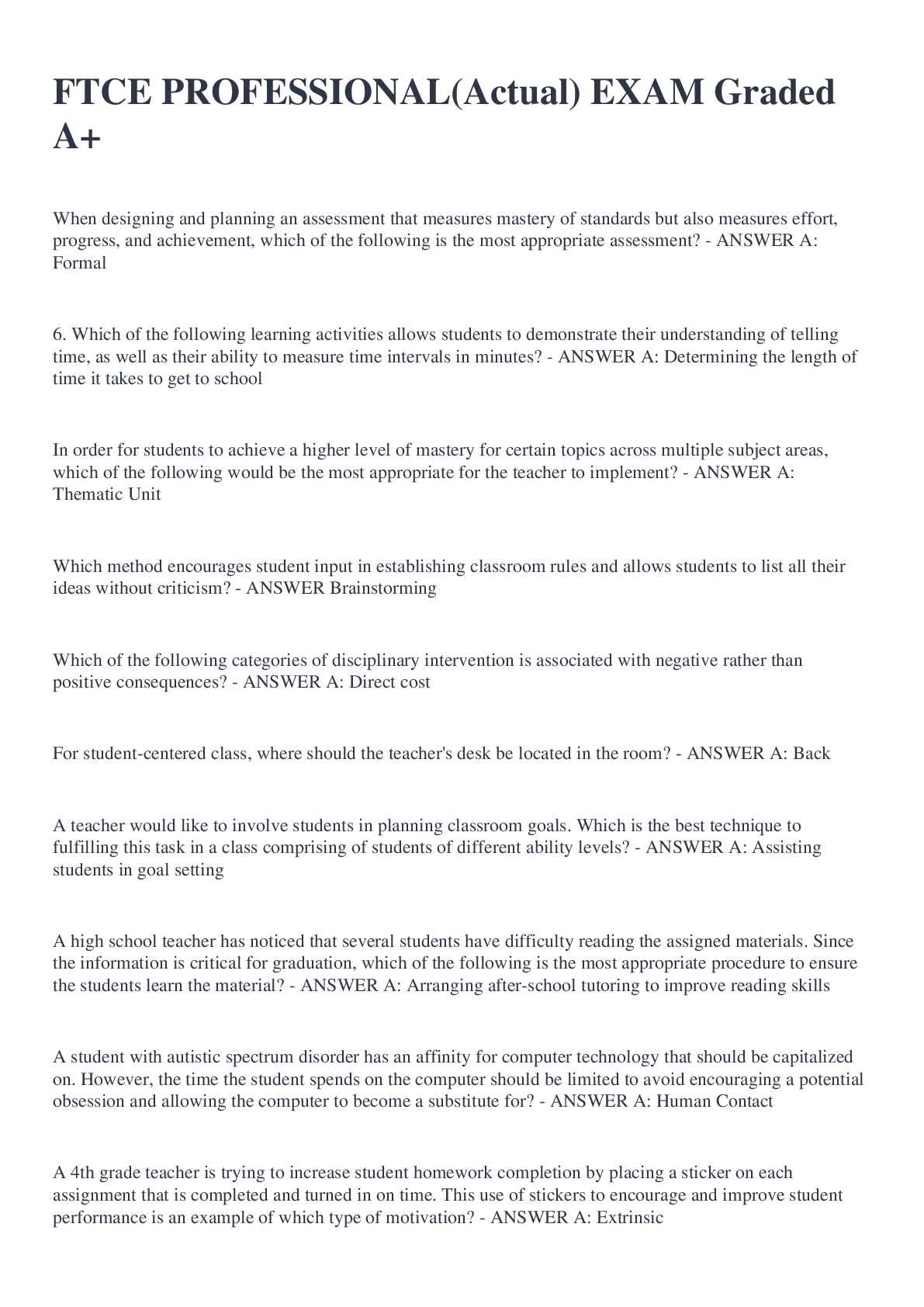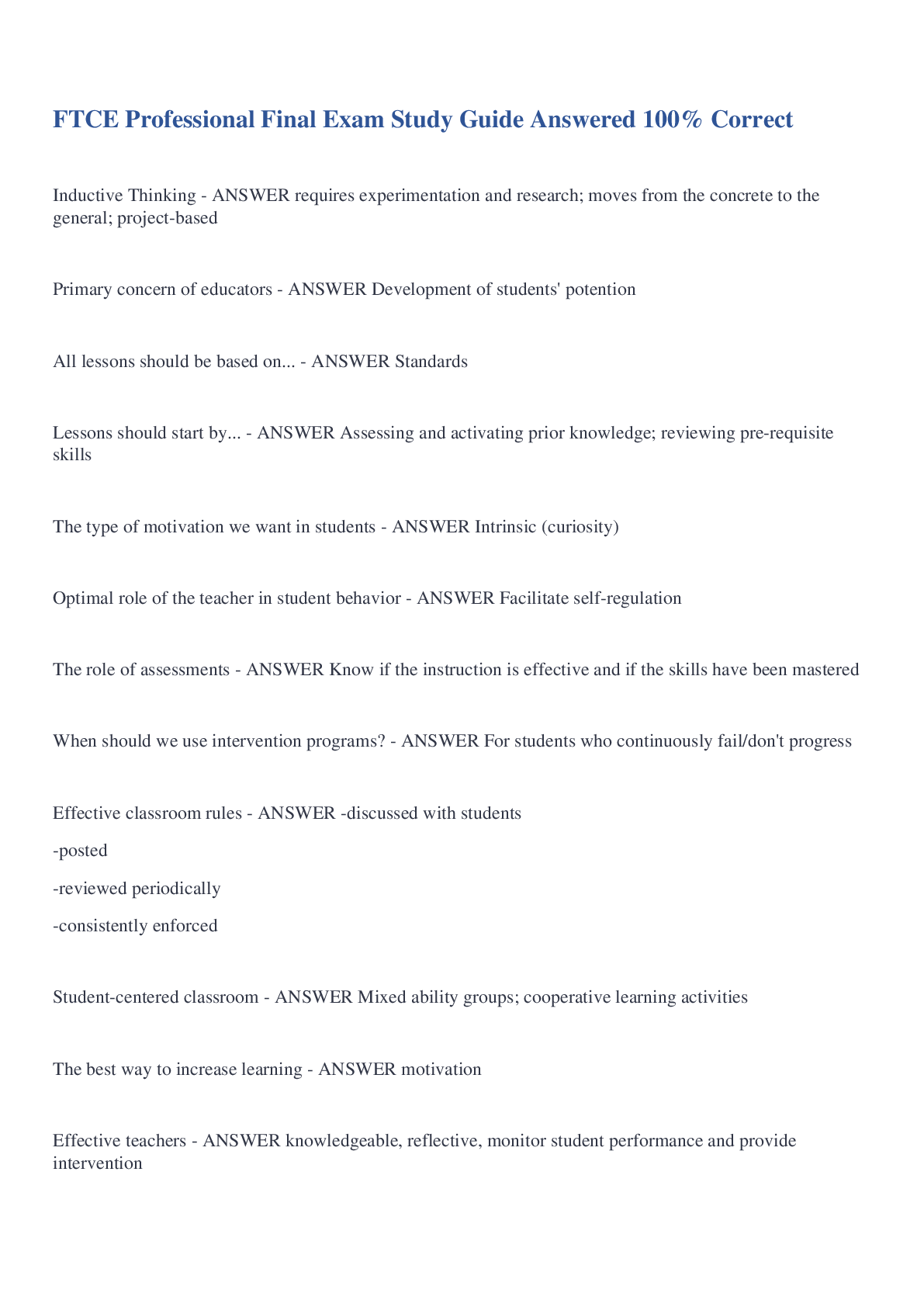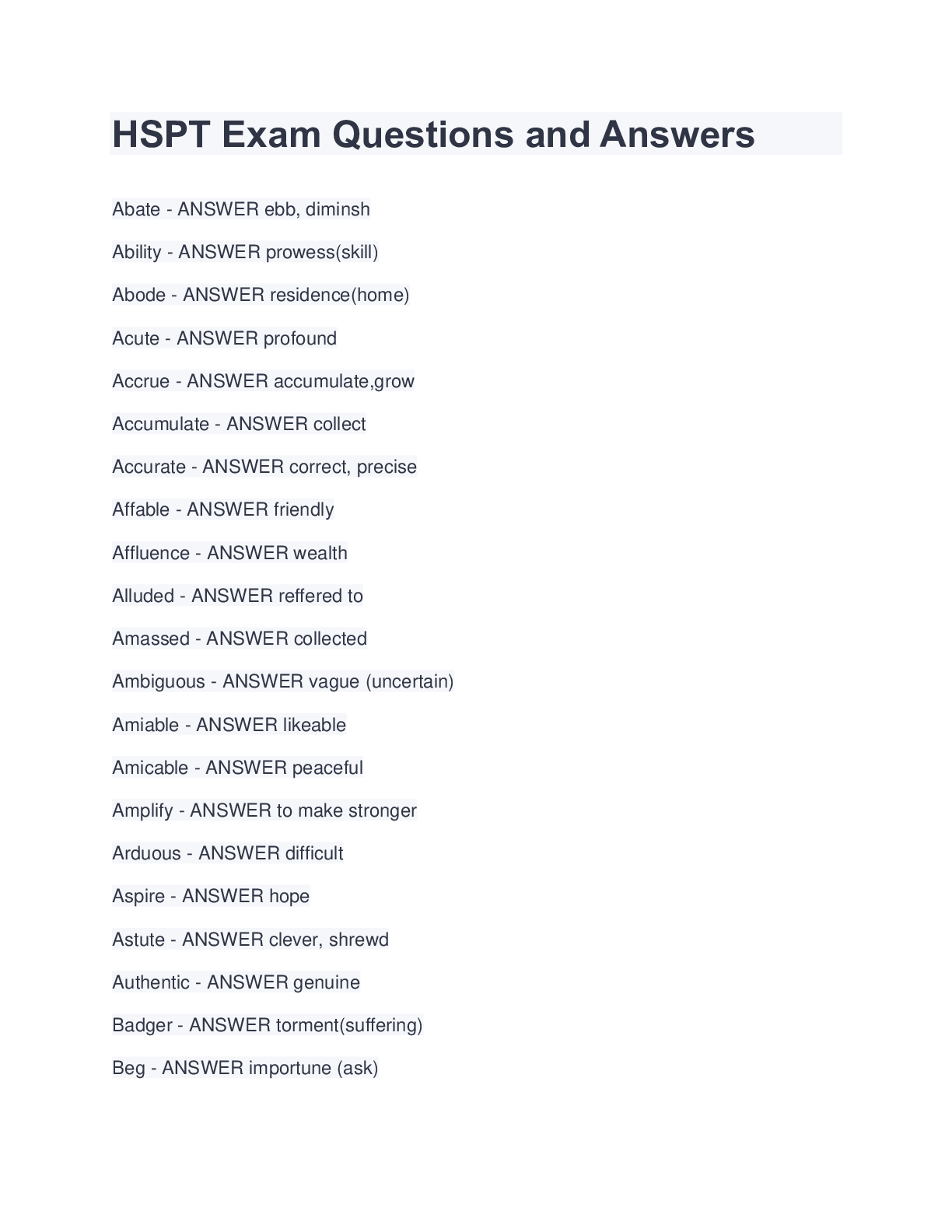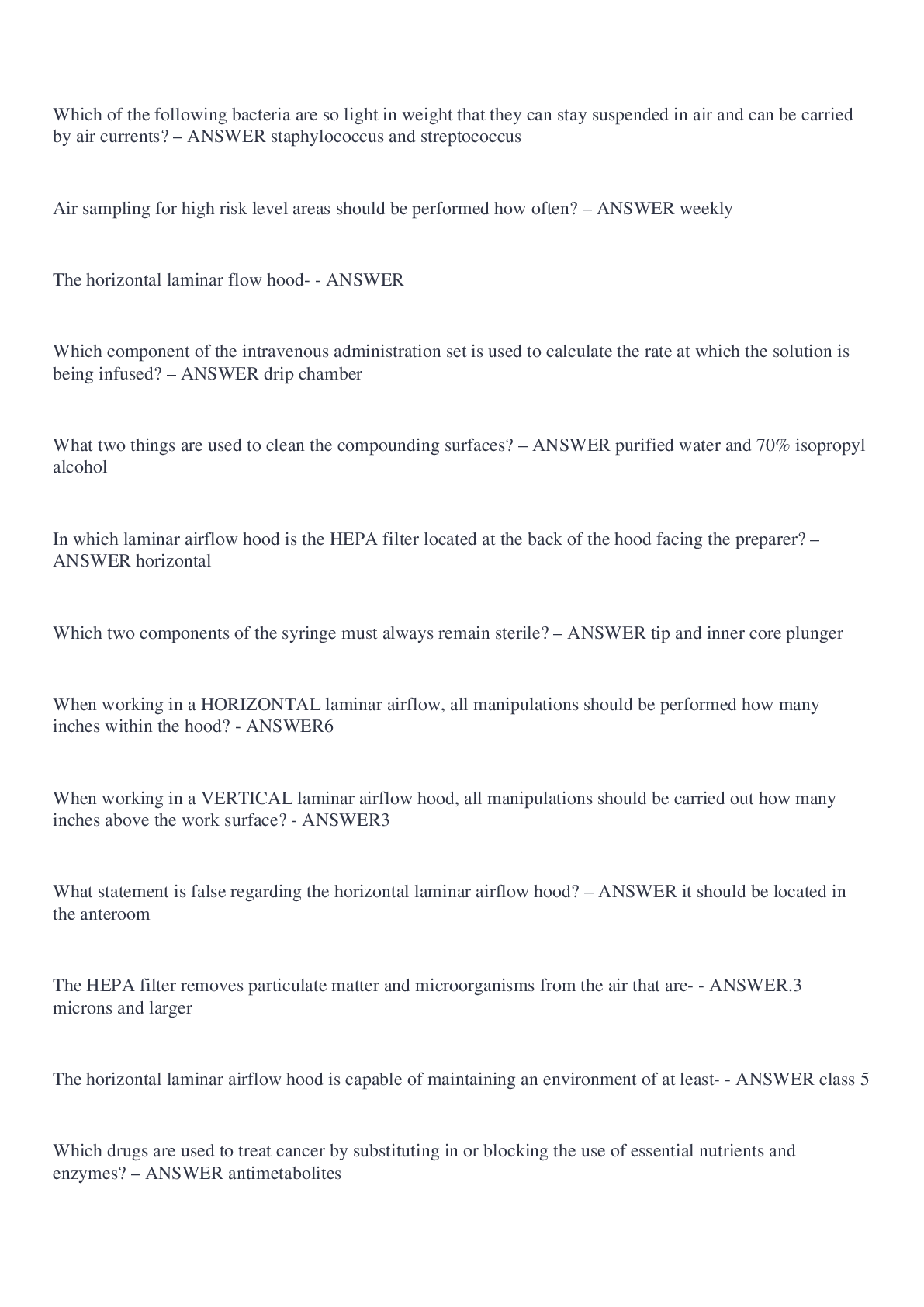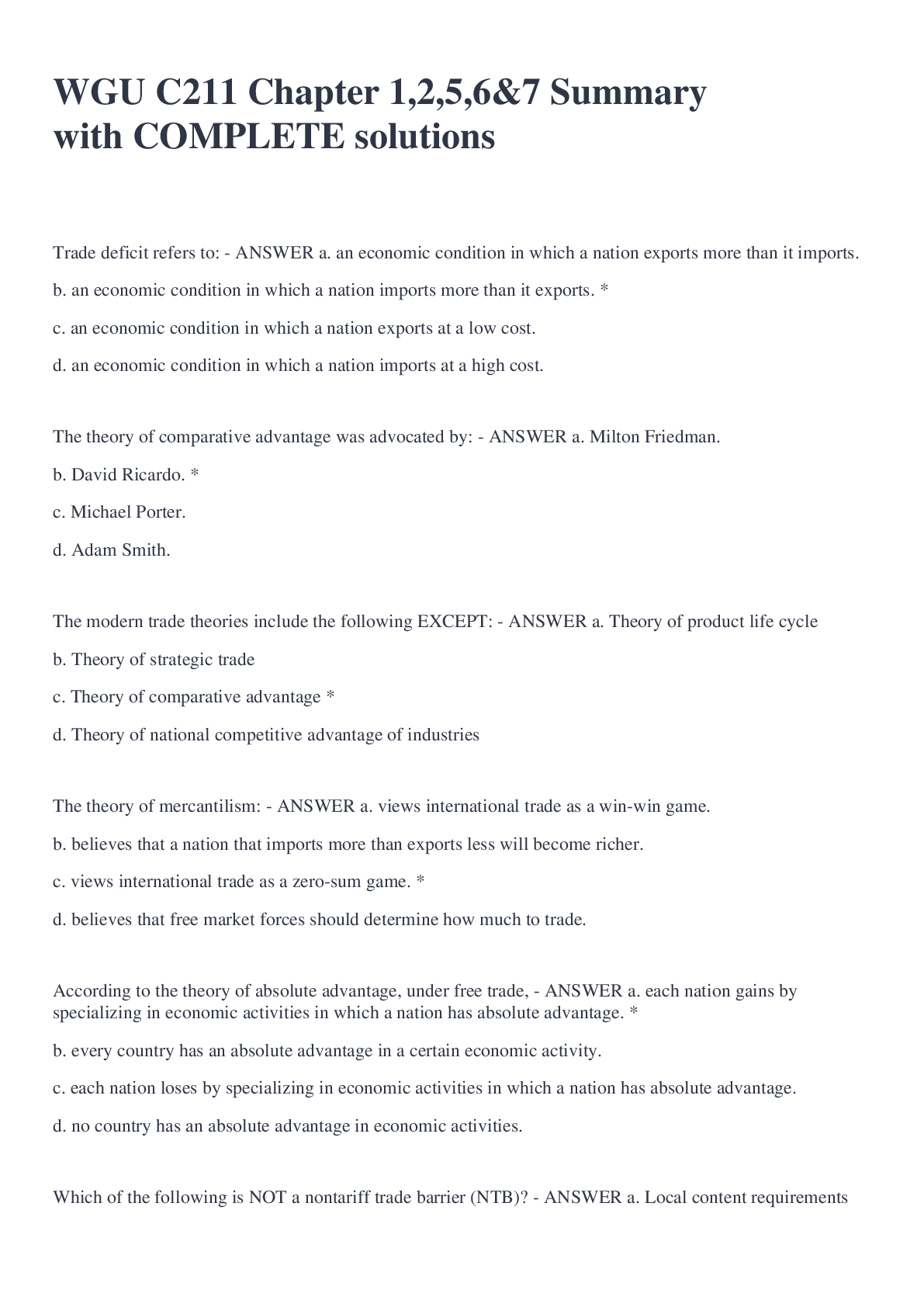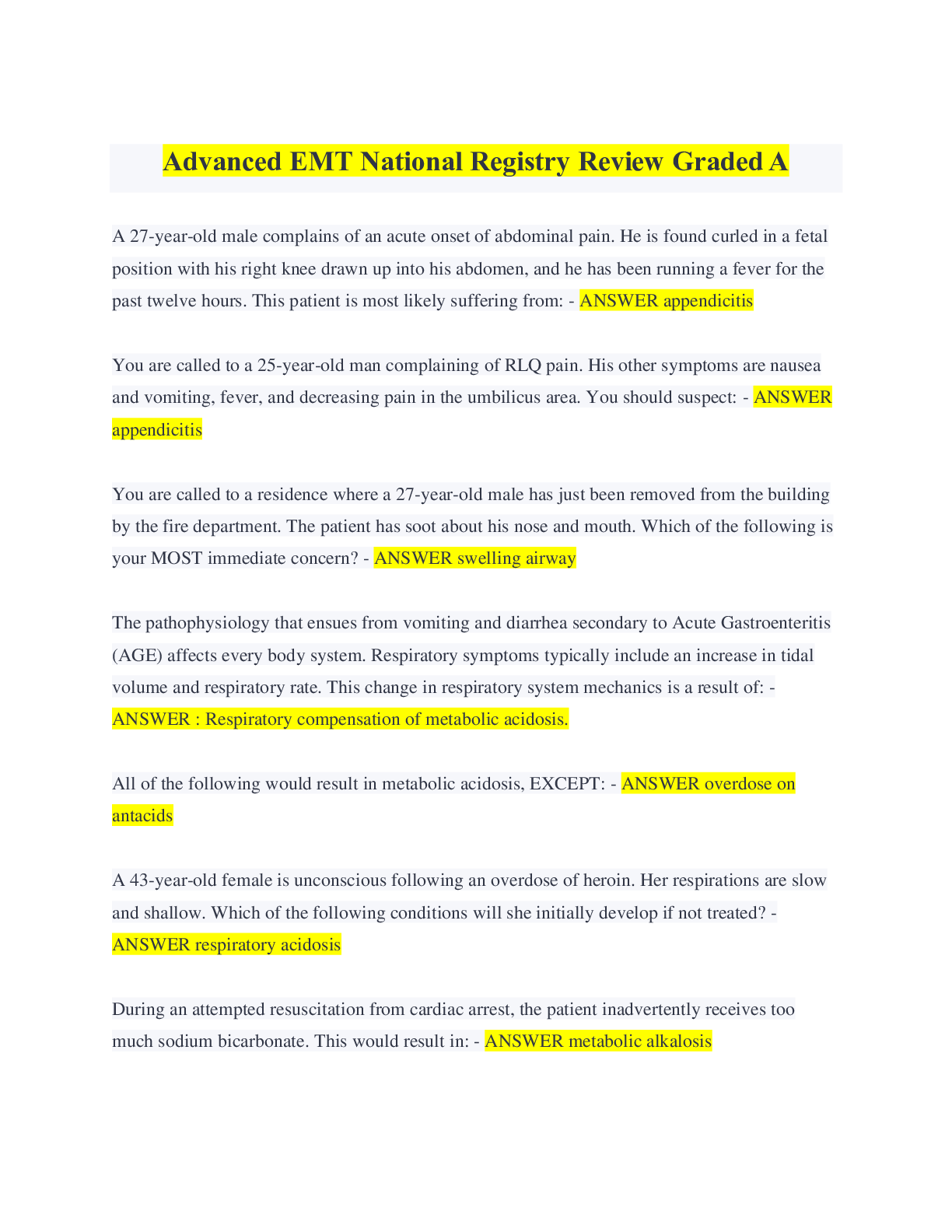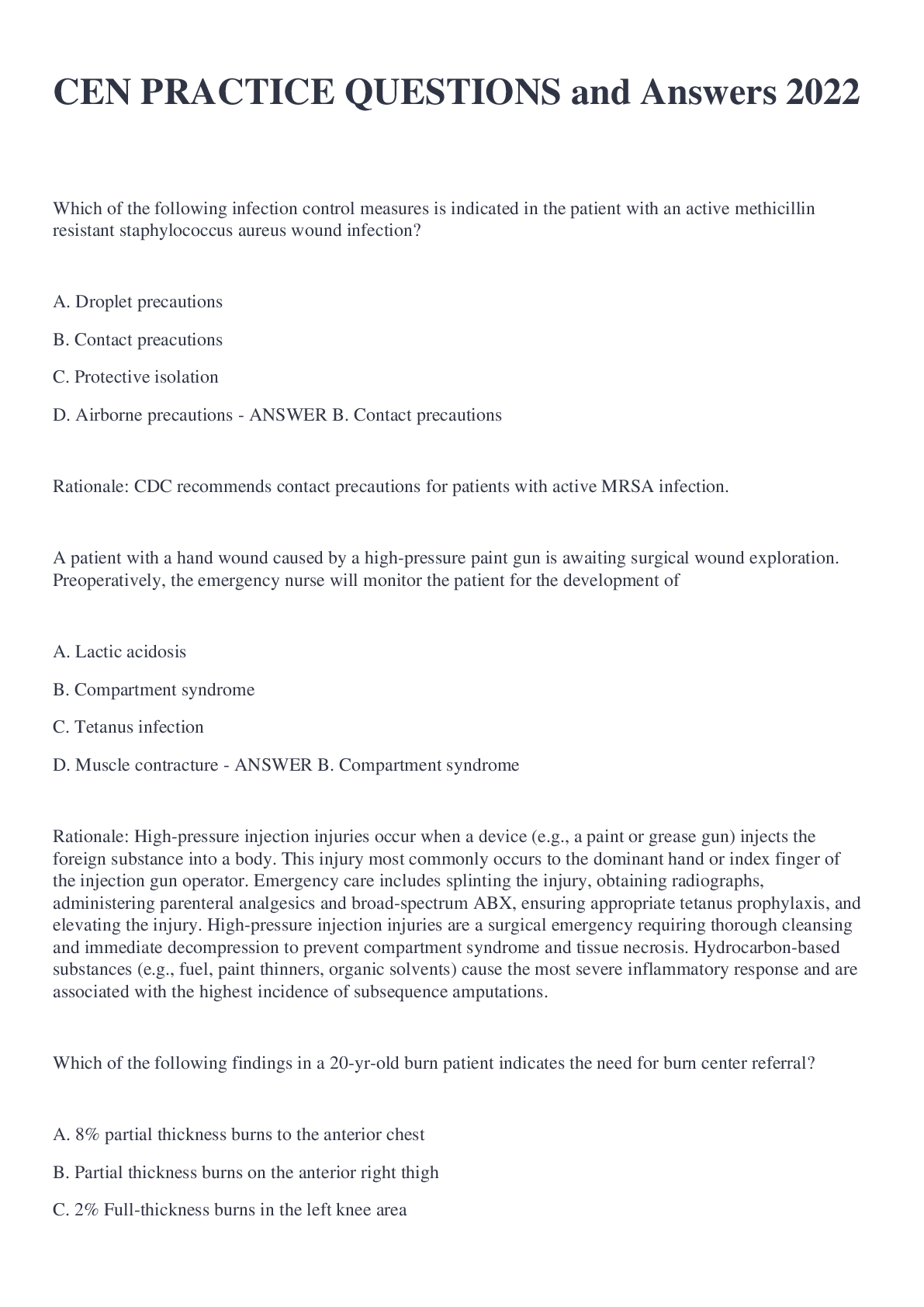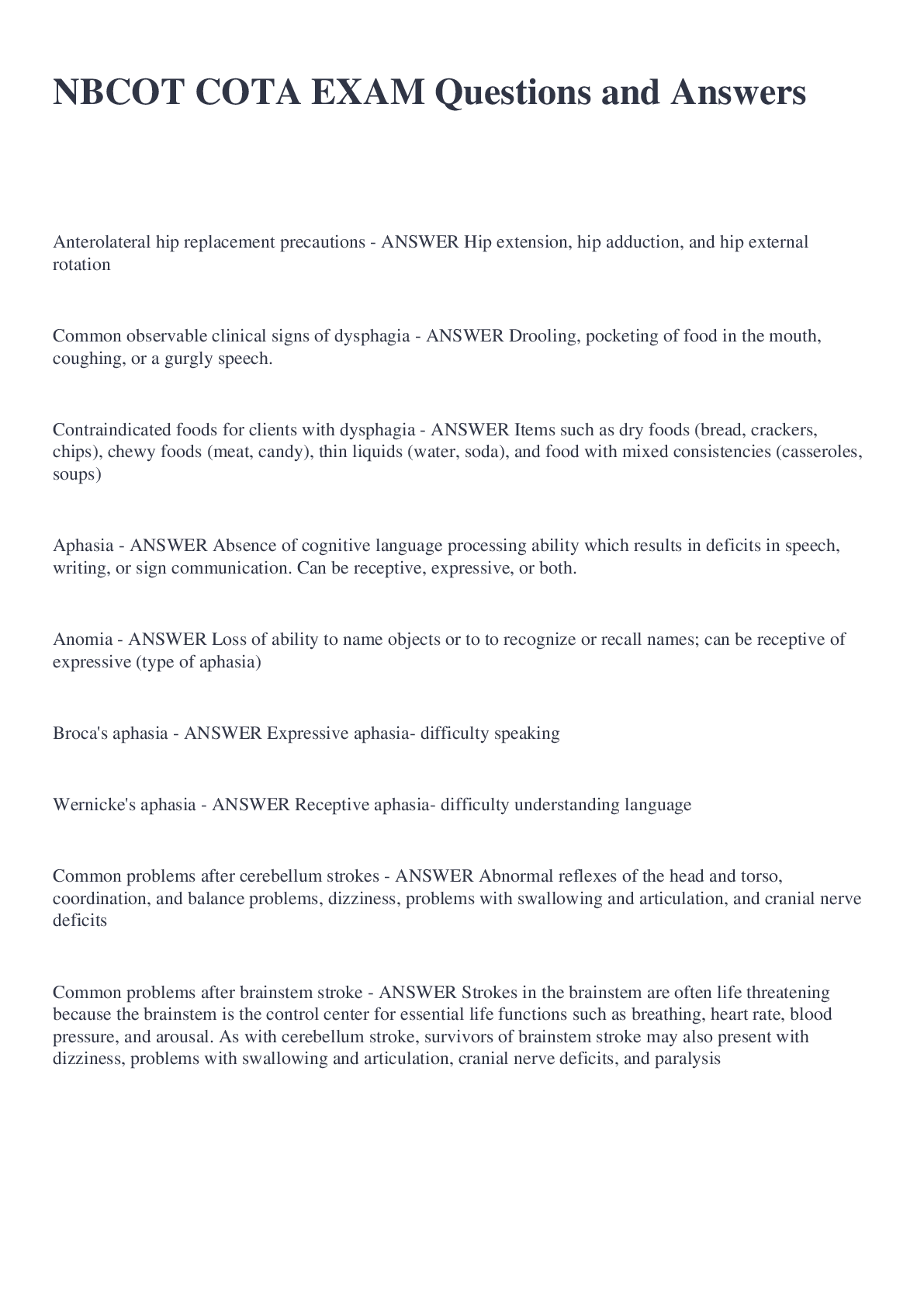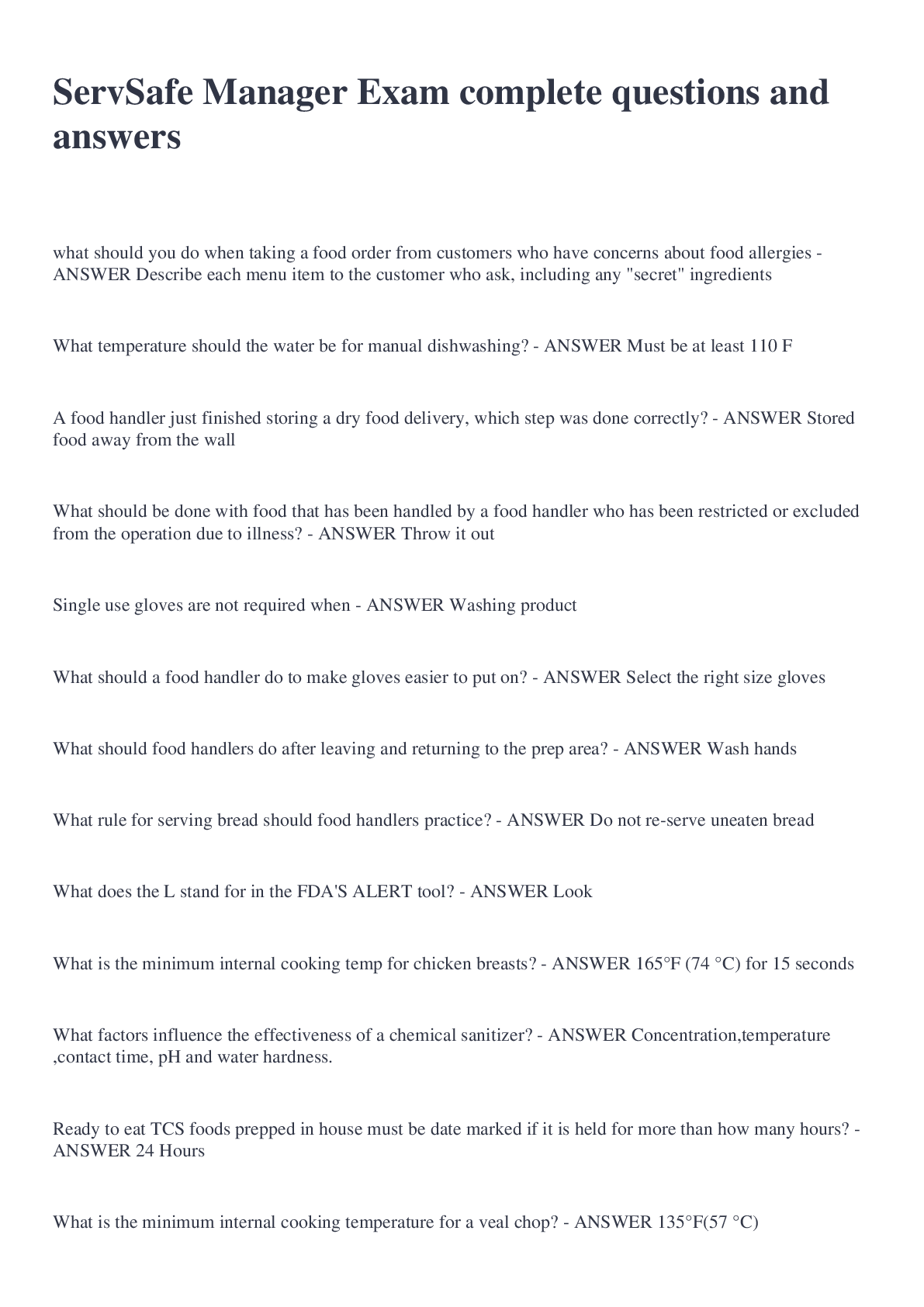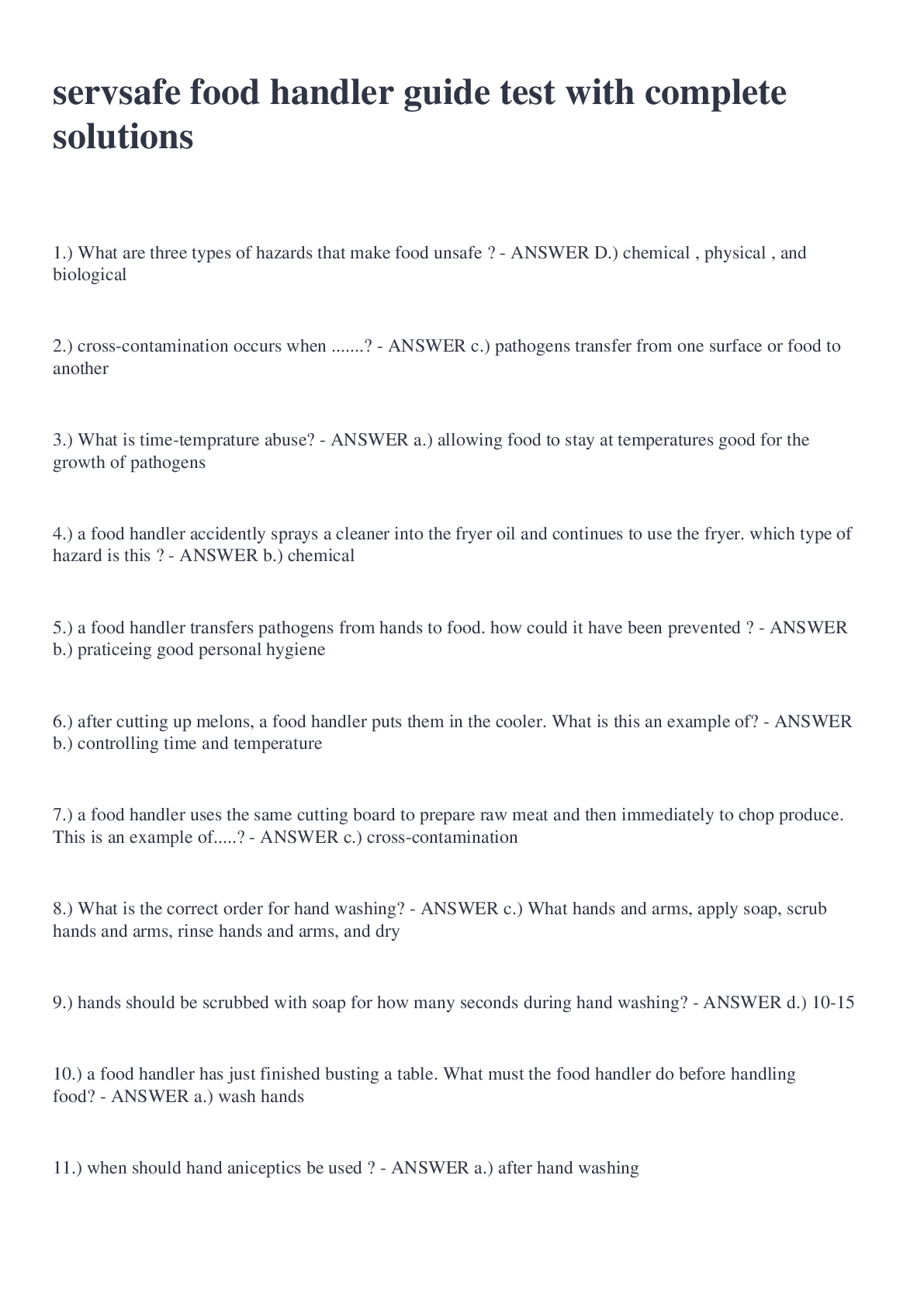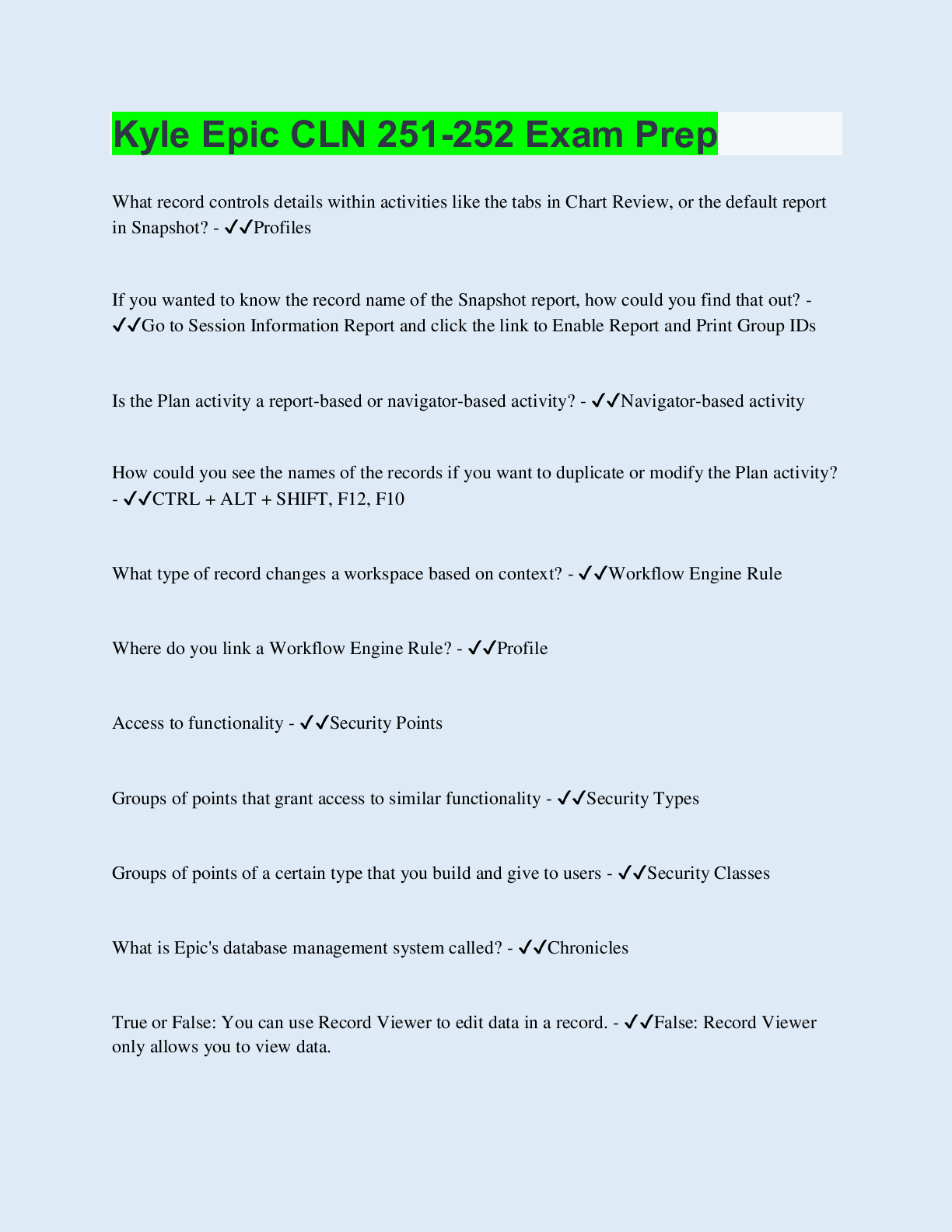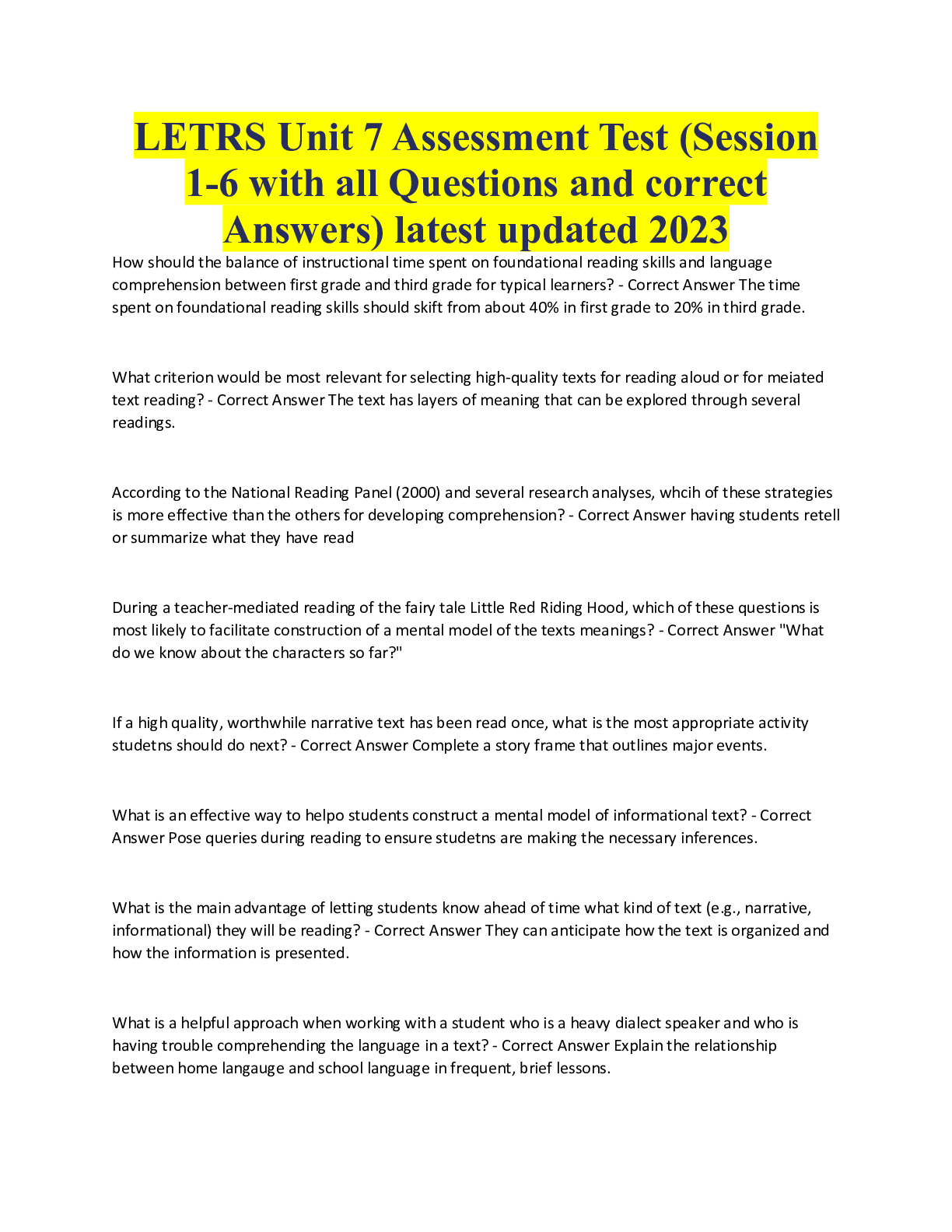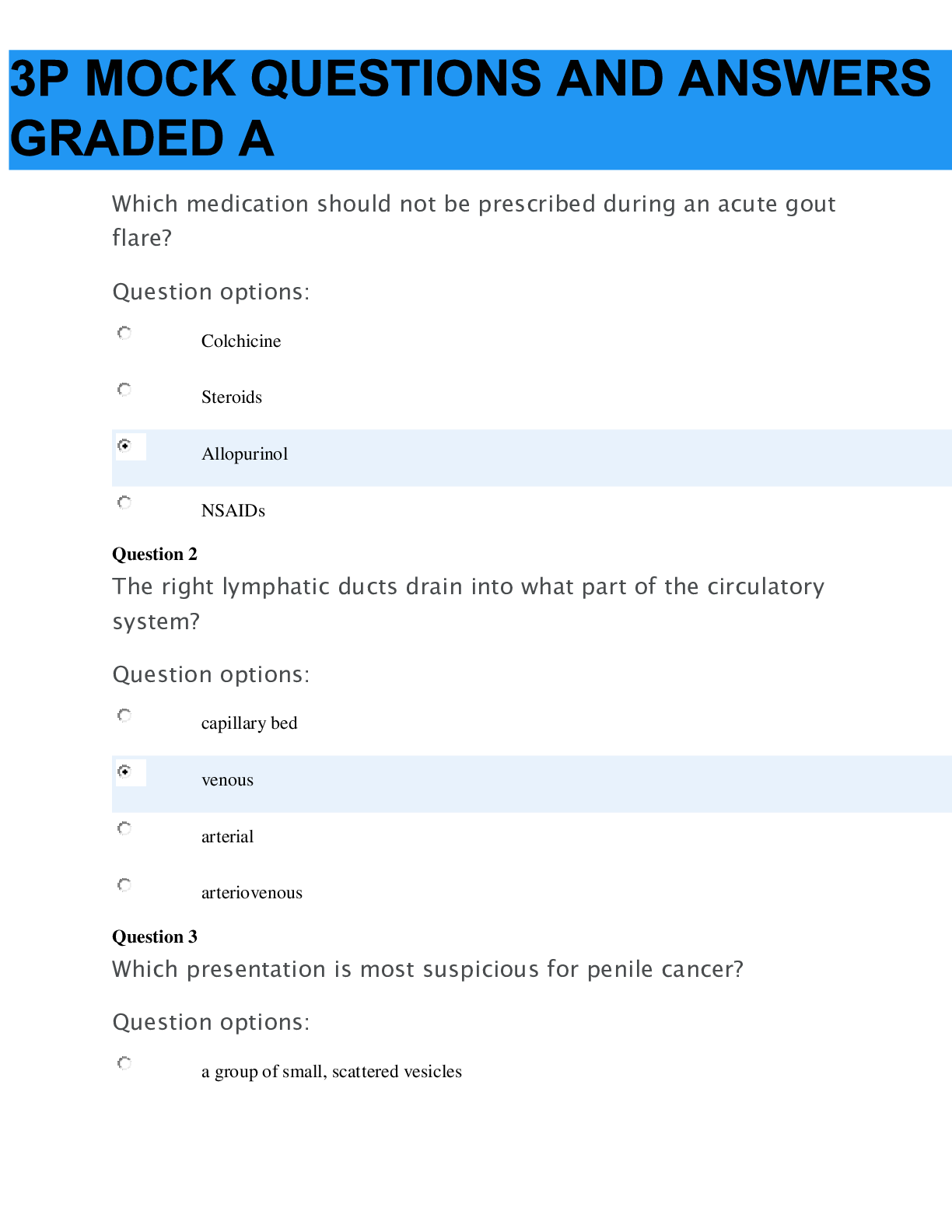Social Sciences > EXAM > CFA Kaplan Mock Questions and Answers 2022/2023 (All)
CFA Kaplan Mock Questions and Answers 2022/2023
Document Content and Description Below
Watson's excessive drinking is unfortunate, but we have no evidence that it has affected his work, professional integrity, judgment, or reputation. If he commits an act involving fraud or dishonesty, ... he would violate the Standard on misconduct. (Module 3.2) Reliable Wealth Managers wants to present a GIPS-compliant performance presentation and reference its GIPS compliance in marketing materials. Reliable is least likely required to: A)claim compliance with GIPS only if it has a compliant performance history of at least five years. B)apply GIPS compliance firmwide and not only to the specific asset classes mentioned in the marketing materials. C)include each discretionary fee-paying account in a composite based on its investment objectives and/or strategies. - ANSWER A) GIPS require a firm to show a GIPS-compliant history for a minimum of five years, or since inception of the firm or the composite if in existence for less than five years. If Reliable has been in business for less than five years, it may still claim compliance with GIPS on a since-inception basis, provided the firm follows all other aspects of compliance. The other choices are requirements for a firm to claim compliance with GIPS. Peter Taylor, a CFA charterholder and a food industry analyst for a large investment firm, has been invited by Sweet Pineapple Co. to visit the firm's processing plants in Hawaii. The Standard concerning independence and objectivity recommends that Taylor: A)use and pay for commercial transportation, if available. B)obtain written permission from his employer before he accepts this invitation. C)decline this invitation if he issues recommendations on the firm's securities. - ANSWER A) The recommended procedures for compliance with Standard I(B) Independence and Objectivity include the recommendation that analysts on company visits pay their own travel expenses and use commercial transportation if it is available. (Module 3.1) Ruth Brett, a Level I CFA candidate, feels nervous and unprepared the night before the exam. Brett writes a few key notes on the bottom of her shoe. At the exam, Brett sees the large number of proctors present and decides not to risk getting caught and does not look at her shoe. According to the CFA Institute Code of Ethics and Standards of Professional Conduct, Brett is: A)not in violation of any Standard or the Code of Ethics because she did not use the notes. B)in violation of the Code of Ethics for bringing the notes into the examination room but is not in violation of any Standard because she did not use the notes. C)in violation of both the Code of Ethics and the Standard governing conduct as participants in CFA Institute programs for taking the notes into the examination room. - ANSWER B) Brett violated both the Code of Ethics and Standard VII(A) Conduct as Participants in CFA Institute Programs. By writing down information from the Candidate Body of Knowledge and taking it into the exam room, she compromised the integrity of the exam, whether she used the notes or not. Her actions are also in violation of the Code of Ethics by not acting "with integrity, competence, diligence, respect, and in an ethical manner." (Module 3.9) Alpha Advisors, Inc., is an investment management firm with a client base that ranges from individuals to large foundations. Which of the following firm policies is least appropriate if Alpha adopts the Code and Standards? Alpha: A)monitors the personal trading activity of firm personnel and requires them to pre-clear personal trades. B)regularly calls larger accounts first after changes in investment recommendations have been faxed to all clients. C)excludes client accounts of family members of employees from participating in IPOs. - ANSWER B) Standard III(B) Fair Dealing requires that all clients be treated fairly. Members and candidates should not discriminate against any client. A family member who is a fee-paying client should not be treated differently from other clients when taking investment action. Following up changes in recommendations with phone calls to larger clients is not a violation of the Standard if the changes have been disseminated fairly. (Module 3.4) Dudley Thompson is a bond salesman for a small broker/dealer in London. His firm is the lead underwriter on a new junk bond issue for Ibex Corporation, and Thompson has sent details of the offering to clients. Thompson calls only his accounts over £1,000,000 for whom he thinks the issue is suitable. Thompson also posts his firm's optimistic projections for Ibex's performance in several Internet chat rooms. According to the Standards concerning market manipulation and fair dealing, Thompson is in violation of: A)both of these Standards. B)neither of these Standards. C)only one of these Standards. - ANSWER B) Thompson has not violated Standard II(B) Market Manipulation by posting his firm's projections for Ibex. A firm's recommendation of a security may increase its price without any intent to mislead the market. The firm has disseminated the details of the offering to its clients fairly, so Thompson may call individual clients without violating the Standard III(B) Fair Dealing. (Modules 3.3 and 3.4) Anne Franklin, CFA, who covers technology stocks, joins a conference call for analysts presented by Cynthia Lucas, chief technology officer for LevelTech. Lucas tells the analysts that overseas shipments of the company's important new product are going to be delayed due to manufacturing defects, which is new information to the analysts. After the meeting Franklin changes her rating on LevelTech from "buy" to "hold" and sends a note to accounts recommending the sale of LevelTech. Franklin: A)did not violate the Standards. B)violated the Standard on nonpublic information by revising her rating on LevelTech. C)violated the Standard on fair dealing by rating the stock a "hold" but recommending sale of the shares to her accounts. - ANSWER B) Telling a selected group of analysts new information does not constitute public disclosure, and therefore acting or causing others to act on this information is a violation of Standard II(A) Material Nonpublic Information. Recommending the sale of a stock rated as a "hold" is not a violation of Standard III(B) Fair Dealing. (Modules 3.3 and 3.4) According to the Standard related to loyalty, prudence, and care, which of the following statements regarding the voting of proxies on client holdings is least accurate? A)Proxies have economic value to a client. B)An investment management firm should vote all proxies on client holdings unless the client reserves that right. C)Members and candidates should explicitly disclose the firm's proxy voting policies to clients. - ANSWER B) Which of the following statements about the CFA Institute's Professional Conduct Program (PCP) is least accurate? A) Possible sanctions include condemnation by a member's peers or suspension of a candidate's participation in the CFA Program. B) If the PCP staff determine that a sanction against a member is warranted, the member must either accept the sanction or lose the right to use the CFA designation. C) Members who cooperate with a PCP inquiry by providing confidential client information to PCP staff are not in violation of Standard III(E) Preservation of Confidentiality. - ANSWER B) Standard III(A) Loyalty, Prudence, and Care does not require the voting of all proxies. A cost-benefit analysis may support the conclusion that the voting of all proxies is not beneficial to the client in light of the time and effort required. Voting on nonroutine issues that have a material impact is required. (Module 3.4) Alvin Gold, CFA, resides in Country T and does business as an investment advisor primarily in Country U. Country T allows trading on non-public information and does not require disclosure of referral fees. Country U prohibits trading on non-public information only if it is gained by illegal means and requires disclosure of referral fees of over $100 (U.S. equivalent). Gold accepts a referral fee of $75, and in the course of a meeting with two other analysts and the firm's CFO, Gold receives material non-public information. To comply with the Code and Standards, Gold: A)need not disclose the referral fee but cannot trade on the non-public information. B)must disclose the referral fee and cannot trade on the non-public information. C)must disclose the referral fee but may trade on the non-public information. - ANSWER B) According to Standard I(A) Knowledge of the Law, Gold must comply with the most strict of the laws of Country T, laws of Country U, and the CFA Standards of Practice. In this case, the most strict rules are those in the Standards of Practice. Standard VI(C) Referral Fees requires the disclosure of all referral fees and Standard II(A) Material Nonpublic Information prohibits acting or causing others to act on the basis of material non-public information. (Modules 3.1, 3.3, and 3.8) Compared to a t-distribution with 10 degrees of freedom, and compared to a normal distribution, a t-distribution with 20 degrees of freedom and the same variance has: Compared to df = 10/Compared to normal A)thinner tails/fatter tails B)fatter tails/thinner tails C)fatter tails/fatter tails - ANSWER A) A t-distribution with sufficiently high degrees of freedom is approximately normal and a normal distribution has thinner tails compared to a t-distribution. The less the degrees of freedom, the fatter the tails. The probability that an acquisition has been executed well is 48%. If it is executed well, the probability of EPS greater than $3.20 is 55%. If the acquisition has not been executed well, the probability of EPS less than or equal to $3.20 is 65%. The unconditional probability of EPS greater than $3.20 is closest to: A)45%. B)48%. C)55% - ANSWER A) The unconditional probability, Prob(EPS>$3.20), is equal to Prob(executed well) × Prob(EPS > $3.20)|executed well) + Prob(not executed well) × Prob(EPS > $3.20|not executed well) = 0.48 × 0.55 + (1 - 0.48)(1 - 0.65) = 0.446 The "up-move factor" in a binomial tree is best described as: A)the probability that the variable increases in any period. B)one minus the "down-move factor" for the binomial tree. C)one plus the percentage change in the variable when it increases. - ANSWER C) The up-move factor equals one plus the percentage increase when the variable goes up, and the down-move factor is equal to one divided by the up-move factor. An analyst estimates a stock has a 40% probability of earning a 10% return, a 40% probability of earning a 12.5% return, and a 20% probability of earning a 30% return. The stock's standard deviation of returns based on this returns model is closest to: A)3.74%. B)5.75%. C)7.58%. - ANSWER C) Expected value = (0.4)(10%) + (0.4)(12.5%) + (0.2)(30%) = 15% Variance = (0.4)(10 − 15)2 + (0.4)(12.5 − 15)2 + (0.2)(30 − 15)2 = 57.5 Standard deviation =√57.5=7.58%Standard deviation =57.5=7.58% An analyst estimates a stock has a 40% probability of earning a 10% return, a 40% probability of earning a 12.5% return, and a 20% probability of earning a 30% return. The stock's standard deviation of returns based on this returns model is closest to: A)3.74%. B)5.75%. C)7.58%. - ANSWER C) On calculator: In DATA: X1=10, Y1=40, X2=12.5, Y2=40, X3=30, Y3=20 In STAT, go to 1-V. Scroll through list to standard deviation = 7.58288. So, probabilities are the Y values... An investment manager has a pool of five security analysts he can choose from to cover three different industries. In how many different ways can the manager assign one analyst to each industry? A)10. B)60. C)125. - ANSWER B) We can view this problem as the number of ways to choose three analysts from five analysts when the order they are chosen matters. The formula for the number of permutations is: n!/(n−r)!= 5!/(5-3)!= 5!/2!= 120/2=60 On the TI financial calculator: 5 2nd nPr 3 = 60. Alternatively, there are 5 2nd nCr 3 = 10 ways to select three of the five analysts, and for each group of selected analysts, there are 3! = 3 × 2 × 1 = 6 ways to assign them the three industries. Therefore, there are 10 × 6 = 60 ways to assign the industries to the analysts. If a two-tailed hypothesis test has a 5% probability of rejecting the null hypothesis when the null is true, it is most likely that: A)the power of the test is 95%. B)the confidence level of the test is 95%. C)the probability of a Type I error is 2.5%. - ANSWER B) Rejecting the null hypothesis when it is true is a Type I error. The probability of a Type I error is the significance level of the test and one minus the significance level is the confidence level. The power of a test is one minus the probability of a Type II error, which cannot be calculated from the information given. Which of the following statements about hypothesis testing is most accurate? A)Rejecting a true null hypothesis is a Type I error. B)The power of a test is the probability of failing to reject the null hypothesis when it is false. C)For a one-tailed test involving X, the null hypothesis would be H0: X = 0, and the alternative hypothesis would be HA: X ≠ 0. - ANSWER A) Type I error is rejecting the null hypothesis when it is true. The power of a test is the probability of rejecting the null hypothesis when it is false. HA: X ≠ 0 indicates a two-tailed test, while HA: X < 0 or HA: X > 0 indicates a one-tailed test. A business cycle theory developed by applying utility theory and budget constraints to macroeconomic models is most closely associated with which school of economic thought? A)Austrian. B)New Classical. C)New Keynesian. - ANSWER B) Real business cycle theory, which derives from applying utility theory and budget constraints to macroeconomic models, is associated with the New Classical school. A central bank is said to have credibility if: A)it issues inflation reports monthly. B)economic actors base decisions on the central bank's stated inflation targets. C)it determines both the policy rate and the method for computing the inflation rate. - ANSWER B) If a central bank has credibility, economic actors come to believe the inflation rate will be near the central bank's target and factor this inflation rate into their decisions. Periodic inflation reports enhance the transparency of a central bank. A central bank that determines both the policy rate and the method for computing the inflation rate is said to have independence. Other things equal, a country is most likely to have a current account deficit if it also has: A)a low savings rate. B)a government budget surplus. C)a low rate of domestic investment. - ANSWER A) As shown by the fundamental macro relationship (X - M) = (S - I) - (G - T), a current account deficit (X < M) is associated with a low savings rate, a high rate of domestic investment, or low government savings (i.e., a budget deficit). Which of the following statements about monopolists is most accurate? A)Monopolists have imperfect information about the demand curve for their product. B)Without government intervention, monopolists will always earn economic profits. C)A monopolist maximizes total revenue where marginal revenue equals marginal cost. - ANSWER A) Demand curves are not observable so a monopolist must search for the profit maximizing price. Because demand information is not perfect, a monopolist is a price searcher. The other statements are false. Although a monopolist can earn positive [Show More]
Last updated: 2 years ago
Preview 1 out of 32 pages

Buy this document to get the full access instantly
Instant Download Access after purchase
Buy NowInstant download
We Accept:

Reviews( 0 )
$12.00
Can't find what you want? Try our AI powered Search
Document information
Connected school, study & course
About the document
Uploaded On
Sep 24, 2022
Number of pages
32
Written in
Additional information
This document has been written for:
Uploaded
Sep 24, 2022
Downloads
0
Views
129

